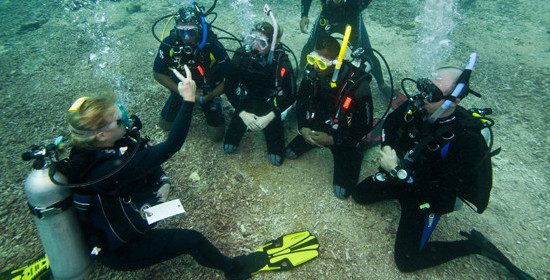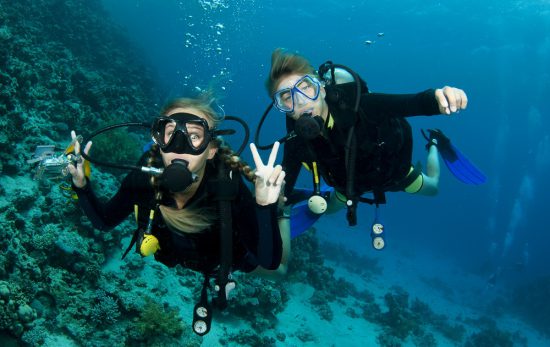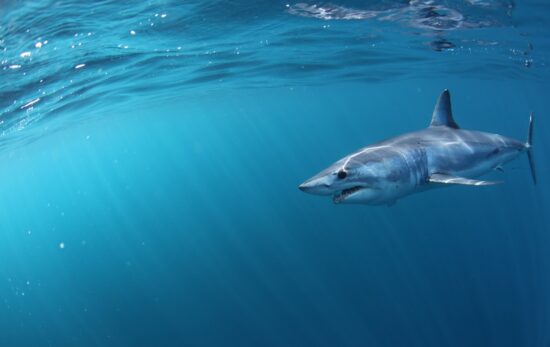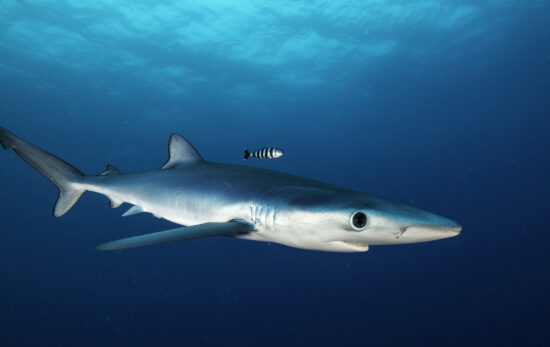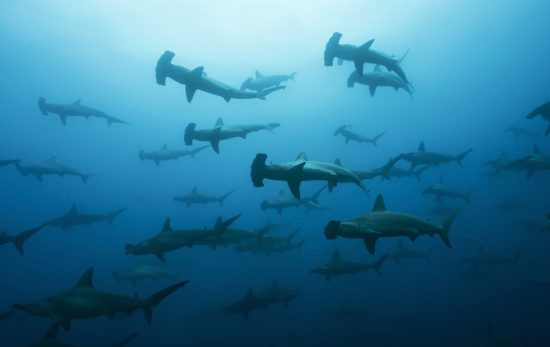Before starting to dive you probably had a different opinion about sharks and especially about sharks and humans. Now that you’re addicted to breathing pressurized air, you realize how awesome it is to see and dive with sharks. If you’re in between these two phases, you’ll soon realize that sharks are very nice creatures, far from being dangerous, and very fun to dive alongside.
Ready to dive with sharks? Read on to learn what you need to know before getting in the water.
Table of contents
- Great White Sharks
- Whale Sharks
- Tiger Sharks
- Hammerhead Sharks
- Bull Sharks (Zambesi)
- Oceanic Whitetip Sharks (Longimanus)
- Nurse Sharks
- Cow Sharks (Sevengill Sharks)
- Reef Sharks
- Other sharks
Types of sharks
Sharks come in all form of shapes and sizes (almost). There are more than 500 different species of sharks in our oceans and every year scientists discover new species. You can dive with most of them. Some require a bit more attention than others, but divers have been with them in the water a number of times.
Let’s have a look at the various types of sharks.
Great White Sharks
Carcharodon carcharias
The most famous one, at least for the number of movie appearances.
The Great White Shark is one of the biggest sharks. It can grow up to 20 feet (6 meters) and weighs up to 2 tons. You can find them in temperate and tropical waters, from the Gulf of Mexico to the Mediterranean Sea, from South Africa to Australia, from New Zealand to Alaska and across the entire Pacific Ocean.
Sharks are the most famous predators in the ocean. Their hunting behavior is fascinating. Seeing them in the water is one of the top dives every adventurous diver wants to do. Remember that you are in front of a machine that evolution didn’t touch for millions of years, just because they are perfect hunters.
You can dive and free-dive in Great White waters with or without a cage. It just depends on how you approach the shark. Diving close to a hunting area or attracting them with tuna heads could be really dangerous without a cage. To dive safely with them, it is mandatory to know their behavior. For this reason, always dive with an expert guide and you will enjoy the most adrenaline-filled encounter in the ocean.

Photo Credit: Elias Levy
Whale Sharks
Rhincodon typus
The biggest shark out there, they can reach up to 42 feet (12 meters) in length but are absolutely harmless.
Whale Sharks are filter feeders, which means that they eat only planktonic organisms and small fishes.
Imagine jumping into the water, turning your head back and seeing a bus-like fish that is swimming gently to you. Encounters with Whale Sharks are astonishing.
Behind their size is a hidden yet sophisticated GPS system that allows them to migrate thousands of miles in the open ocean.
Snorkeling or diving with them is a great adventure. The Ari Atoll in the Maldives is one of the most famous sites where you have a high chance of seeing a Whale Shark.
Get on board and look at the surface of the ocean. A giant shadow is coming close to you. Grab your fins and mask and jump into the water.
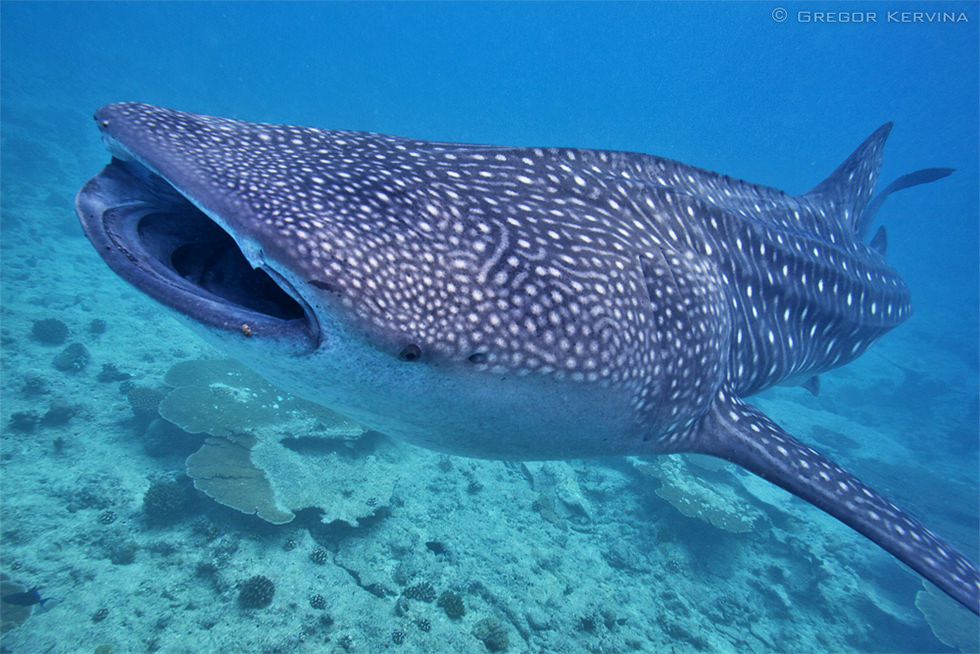
Photo credit: Gregor Kervina
Tiger Sharks
Galeocerdo cuvier
Tiger Sharks are named for the dark, vertical stripes found mainly on juveniles. As these sharks mature, the lines begin to fade and almost disappear. They are among the biggest sharks in the ocean at 20 feet (6 meters) in length.
Although they are big hunters, they are mainly scavengers. This means they eat dead organisms and actually a nearly limitless menu of diet items.
As majestic and slow swimmers, an encounter with a Tiger Shark is amazing, not only for its size but also for its elegance.
If you are brave enough to dive with this incredible creature, we can suggest many places in the world where you can find them and of course crazy diving guides that are eager to bring you in front of a Tiger Shark!
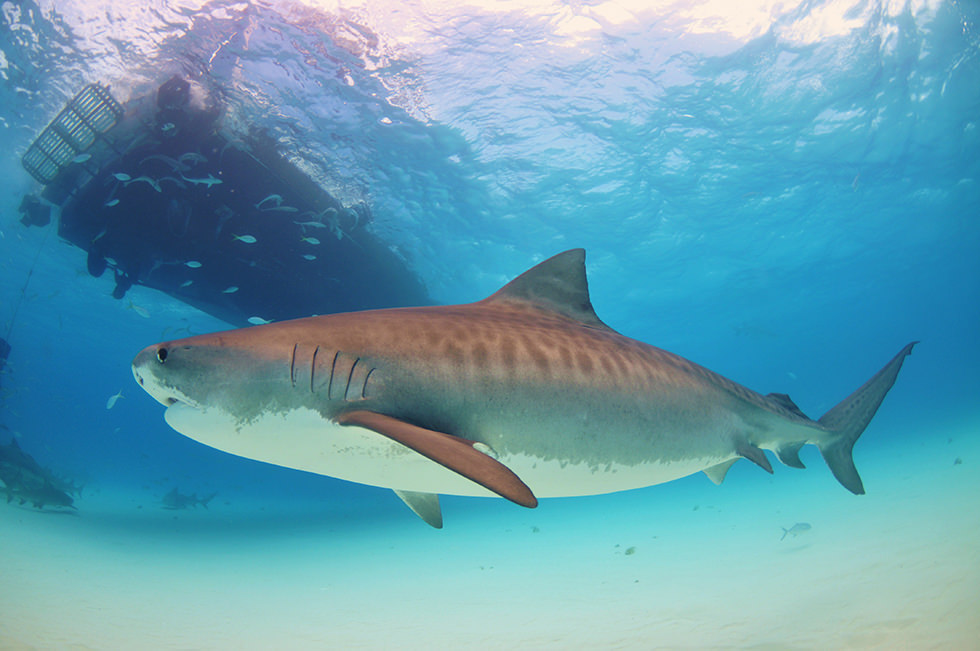
Photo credit: Albert Kok
Hammerhead Sharks
Family: Sphyrnidae
Up to 20 feet (6 meters) in length, Hammerhead Sharks are the easiest to recognize thanks to the particular head shape, reminiscent of a hammer. The strange shape allows them to see almost 360° and use a highly specialized detector of electric and magnetic fields. This means they can move in the blue water of the ocean, without any reference points, yet remain perfectly oriented. As one might surmise, they are unbelievable hunters.
Hammerhead Sharks are distributed in all tropical waters. Among the best locations for hammerhead diving are the Galapagos, Bimini Island, Costa Rica, Hawaii, the Maldives and Indonesia.
Just take your time and think about a great dive surrounded by hundreds of Hammerhead Sharks!
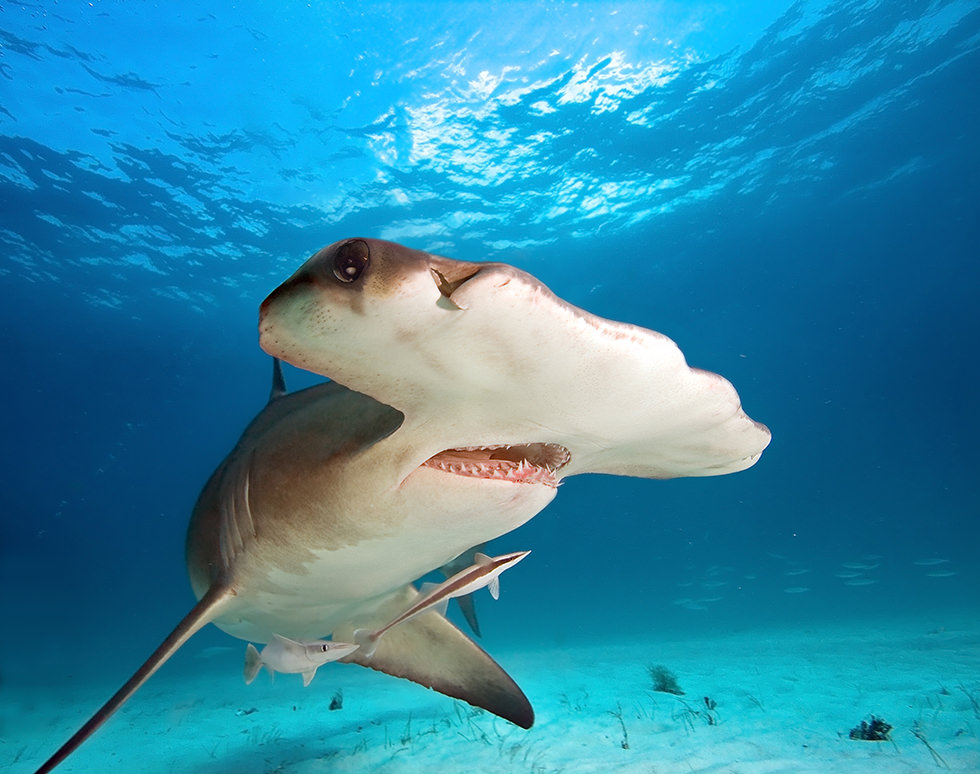
Bull Sharks (Zambesi)
Carcharhinus leucas
The Zambesi Shark is one of the most aggressive species of shark together with the Great White and Tiger Shark. A common myth about Bull Sharks is that they have the highest level of testosterone in the entire animal kingdom.
This shark has more testosterone than a whole team of rugby players. Zambesi Sharks, as they are called in South Africa, are also well known for their ability to swim in freshwater rivers and even reach lakes many miles inside the coast.
Are you brave enough? If so, take this challenge and follow us underwater to look for the Zambesi Shark! Take your equipment and jump in the warm water of Mexico, the Bahamas, Kenya, India, Thailand or Indonesia.
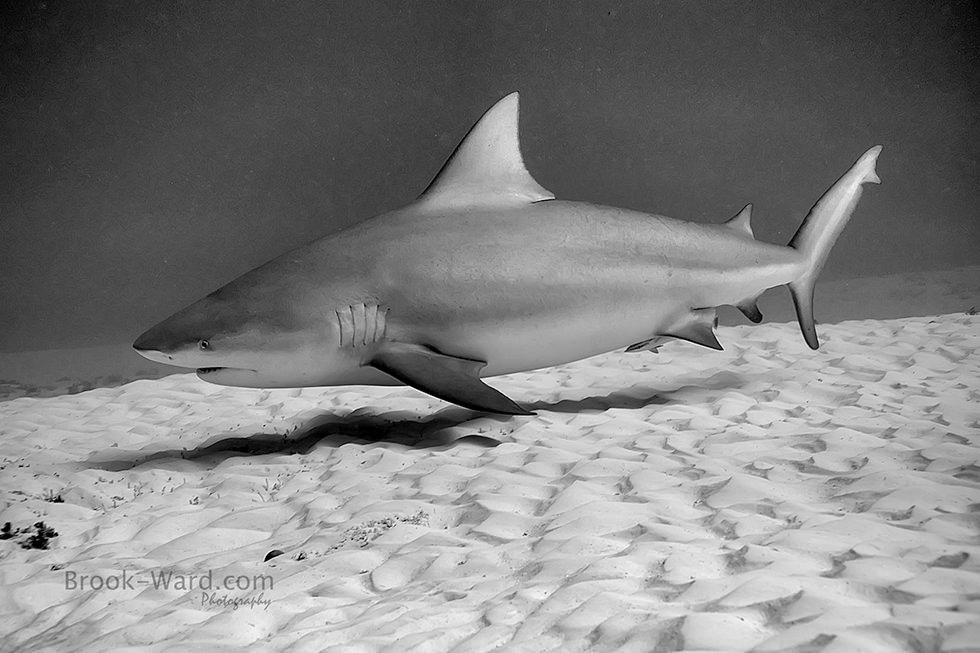
Photo credit: Brook Ward
Oceanic Whitetip Sharks (Longimanus)
Carcharhinus longimanus
A beautifully shaped shark!
The Longimanus is an easily distinguishable species due to its long and robust, paddle-shaped pectoral fins. Although the most distinctive features are the white tips on the first dorsal, pectoral, pelvic and caudal fins. The adults can grow up to 13 feet (4 meters). They are rarely observed in a group. Rather, they are most often solitary and in open waters.
The Oceanic Whitetip Sharks are famous for their curiosity, swimming very close to divers or following boats and others animals, mostly due to their search for food. They eat almost everything, but prefer pelagic fish.
Diving with Longimanus Sharks is easy, the Red Sea and tropical waters are the home-water of this majestic shark. For any information related to how to dive with this shark, just contact us!
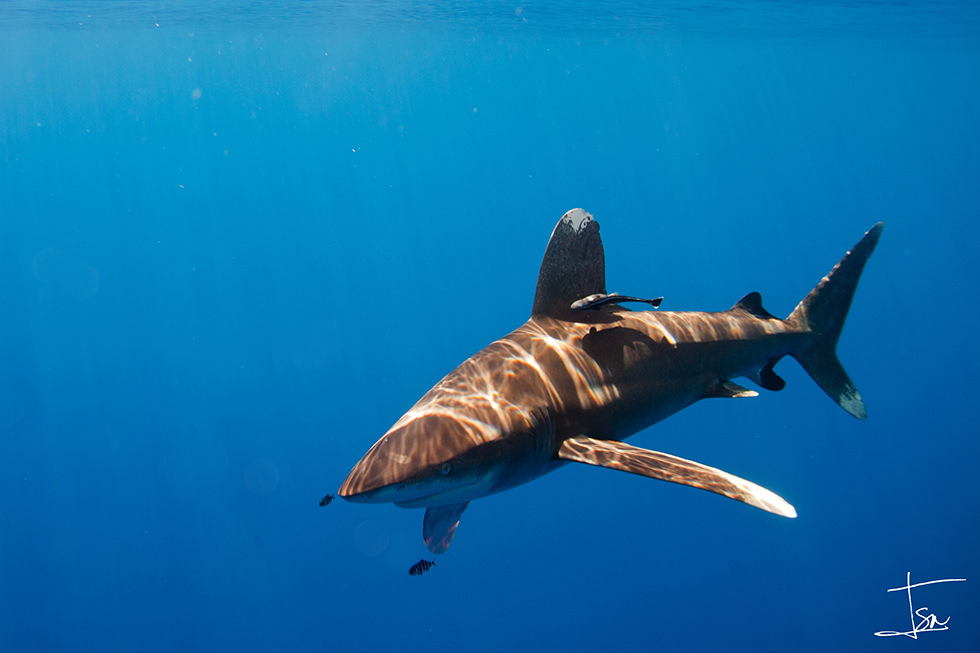
Photo credit: Isaias Cruz
Nurse Sharks
Ginglystoma cirratum
While pelagic species, including sharks, must keep moving in order to breathe, Nurse Sharks can remain motionless, lying on the seafloor under tabular corals or inside caves. They are mainly active during the night, allowing divers to easily enjoy an encounter during the daylight hours. Nurse Sharks are bottom dwellers, feeding primarily on sea snails, crustaceans, molluscs and other small fish that are sucked into and then crushed in the mouth. These sharks also possess sensory barbells that protrude from their upper lip, allowing them to feel the presence of their prey in the environment and mainly under the sand.
They are present in the warm waters of all oceans, from the African coast to the paradise of the Maldives, Australia and the tropical waters of the Atlantic and Pacific oceans.
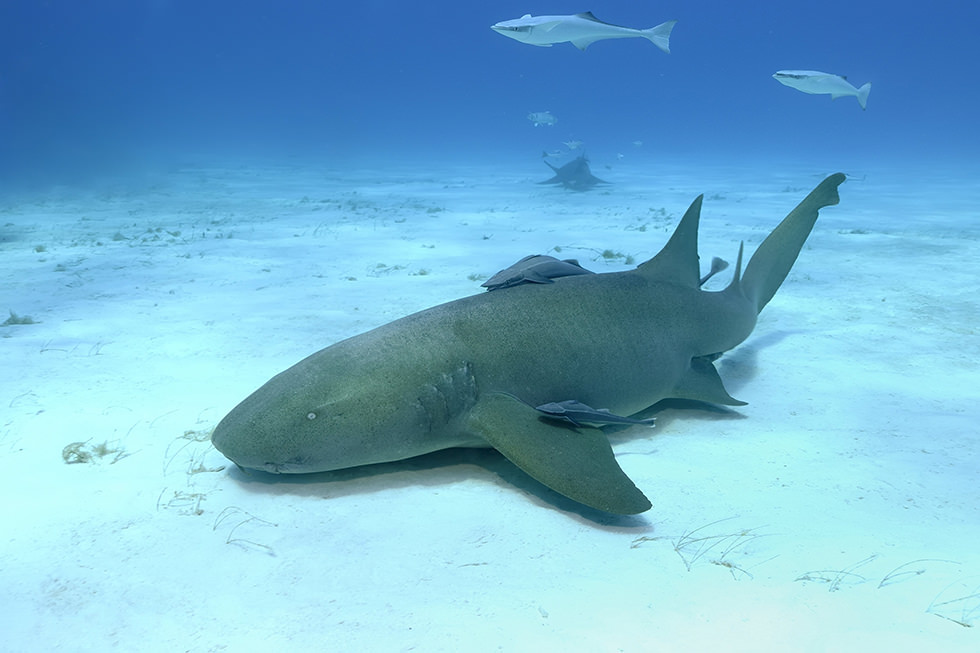
Cow Sharks (Sevengill Sharks)
Family: Hexanchidae
Cow Sharks are considered one of the most primitive sharks. Their skeletons resemble those of ancient extinct forms. Their most distinctive feature is the presence of a sixth or seventh gill slit, in contrast to the five found in all other sharks. They can grow up to 16 feet (5 meters) in body length and are very good hunters. They live in the deep and cold water of all the oceans from New Zealand to South Africa and from the Atlantic Ocean to the Mediterranean Sea. Diving with Cow Sharks is not that easy due to the rarity of encounters in coastal and shallow waters, but in some places you have a higher chance of spotting these sharks. The kelp forests in South Africa and California are, for example, the ideal habitat for seeing this prehistoric hunter!
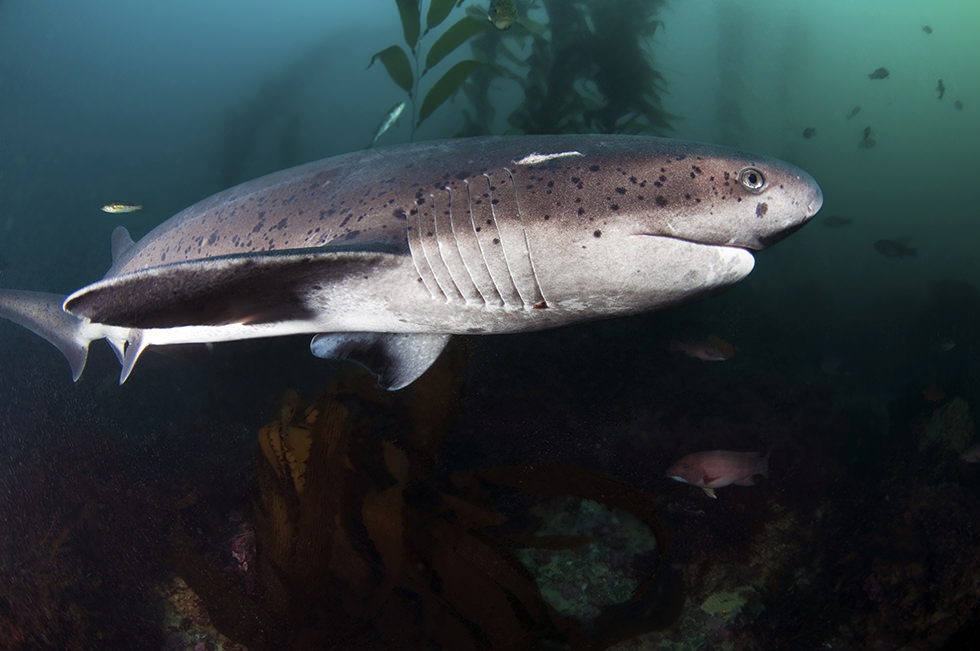
Reef Sharks
Caribbean Reef Shark (Carcharhinus perezii)
Blacktip Reef Shark (Carcharhinus melanopterus)
Grey Reef Shark (Carcharhinus amblyrhynchos)
Whitetip Reef Shark (Triaenodon obesus)
Reef Sharks are the apex predators of the reef ecosystem. Caribbean, Grey, Blacktip and Whitetip Sharks are the most common species that you will find in the reefs of all oceans. These sharks usually don’t exceed 10 feet (3 meters) in length. However they are great hunters, feeding mainly on small reef fish, crustaceans and molluscs.
Spotting Reef Sharks is very easy. They are abundant around the reefs of all tropical waters in the Atlantic and Indo-Pacific Oceans. Just reach your favorite tropical place and dive as much as you can to enjoy an encounter with a school of Reef Sharks. It will turn a normal dive into a great dive.
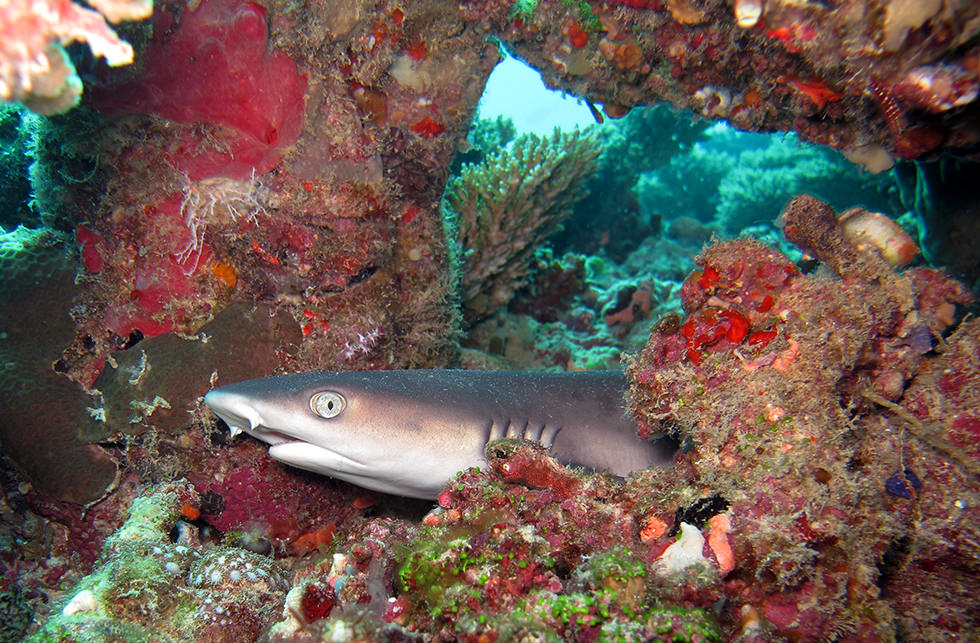
Photo credit: Sandro Lonardi
Other sharks
Of course the ones mentioned above are only a small percentage of all the sharks species. I haven’t forgot the Lemon Shark, Blue Shark, Basking Shark and all the other many species you can find in the ocean.
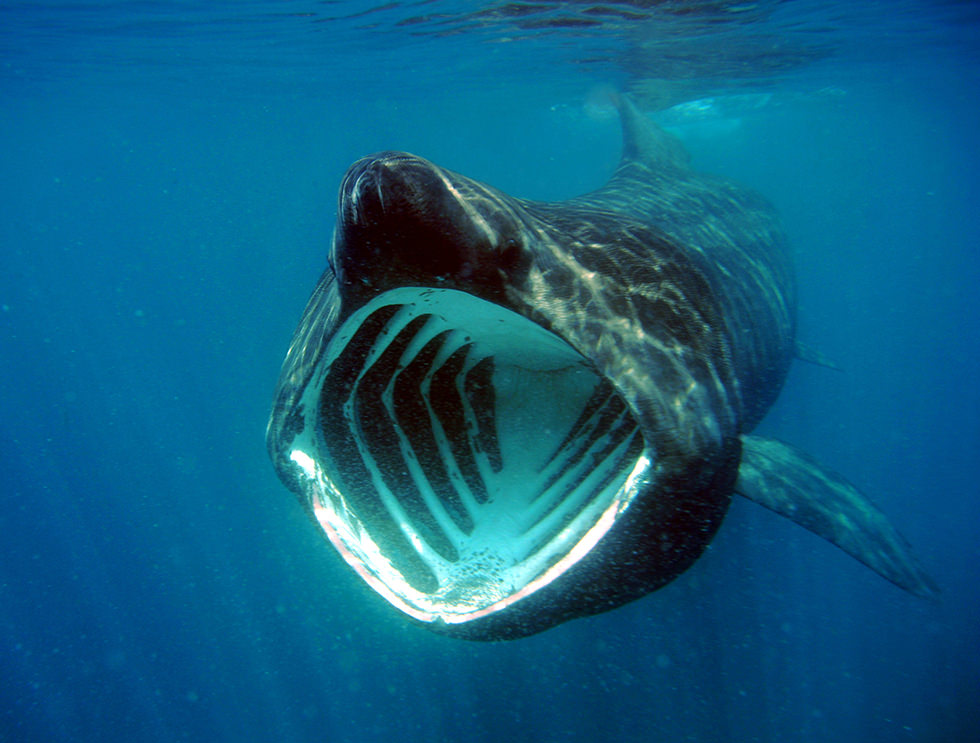
Shark attacks
Being attacked by a shark is quite rare, but could happen. Do you know that every year there are about 60 confirmed shark attacks around the world? But why do sharks attack? First of all, you have to know that, fortunately, you are not on their menu. Most of the time they bite us because they are curious or frightened. Attacks can be provoked or unprovoked, and observations have shown that there are potentially 6 factors as reasons for shark attacks:
- Food in the water
- Confusion of senses
- Competition
- Animal personality
- Conditioning
- No respect
That doesn’t mean that if you swim close to a shark you will be attacked by it. In fact, we can name 18 things more dangerous than sharks. You just have to remember that there is always a hazard, because they are wild animals.
If we compare sharks with other animals we find out, for example, that mosquitoes transmit diseases like malaria to more than 700 million people every year, and around 2 million of them die. And what about dogs? In the USA, dogs bite 368,000 people per year and in the last 6 six years, there was an average of 31 fatal attacks per year.
We are often frightened by sharks, but did you know that two seemingly harmless creatures are among the most poisonous of the planet? Most pufferfish contain a toxin in their body that could potentially kill 30 adults. But nothing compares to the poison of the small golden poison dart frog, whose poison is contained in the mucus that covers its skin. One gram of this toxin can potentially kill almost 6,000 people!
To have an idea of the risk of shark attacks take a look below:
Confirmed unprovoked (1958–2014):
- Total: 2,899
- Fatal: 548
Only 5-15 of attacks annually are fatal.
Now think that more or less 79 million sharks are killed each year by humans. So who is really more dangerous?
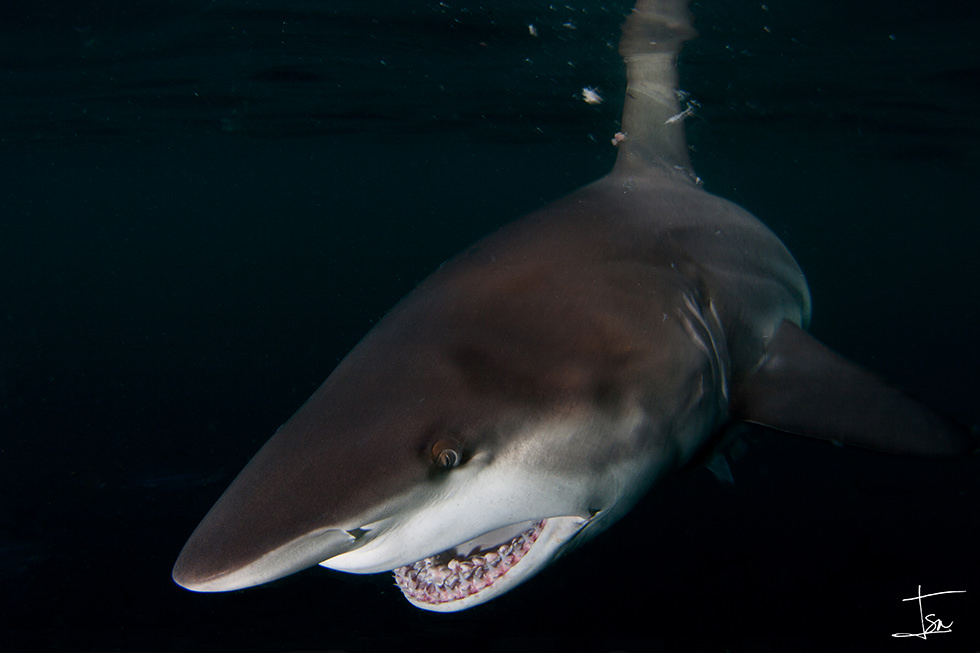
Photo credit: Isaias Cruz
Shark conservation
Sharks are stunning creatures. They have existed for almost 400 million years. It is incredibly frustrating and sad to know that they are disappearing. Why? Because of humans of course. Shark finning, bycatch, habitat destruction and overfishing are the main causes of their endangerment.
The demand on shark products is very high. For example, shark fin soup is a delicacy, especially in China. It is thought that this soup is a natural remedy for boosting sexual potency, enhancing skin quality, preventing heart disease and lowering cholesterol, but different studies have shown that this is incorrect. Other in-demand products are shark cartilage, shark liver oil, shark teeth and jaws, shark leather and even manta ray gills.
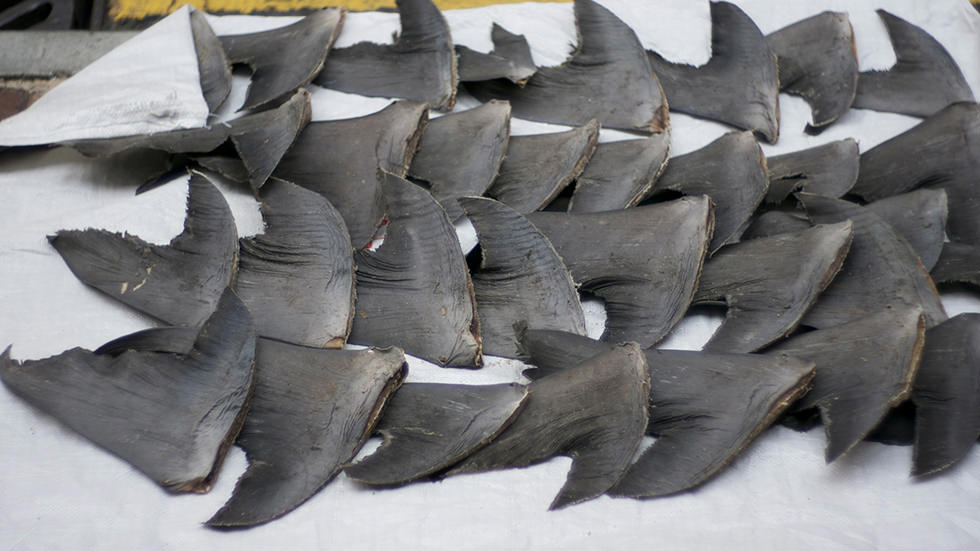
Photo credit: Nicholas Wang
Why sharks are so important
Sharks are defined as “top predators.” The role of a top predator is to keep the balance in the complex food web of the marine ecosystem. A number of scientific studies demonstrate that depletion of sharks results in the loss of important fish and other organisms that keep the ecosystem healthy. If you’d like to continue to enjoy the beauty of the ocean while diving, it is your duty to save the sharks!
What you can do to help these animals
You should avoid buying the products mentioned above. If there is no demand, it is unnecessary to kill all these creatures.
Ecotourism can also help sharks as well as other marine life. The definition of ecotourism is: “Responsible travel to natural areas that conserves the environment, sustains the well-being of the local people, and involves interpretation and education”.
A dead shark has less market value than a living shark. Scientific studies have shown that the fin of a dead shark on a restaurant menu brings in less money than a shark swimming in the ocean and attracting ecotourists. In this way, ecotourism has a massive impact on the protection of marine life.
So let’s go diving with sharks!

Shark feeding
Have you ever heard about shark feeding? While we are discussing ecotourism, we should mention that sometimes it is not easy to see sharks. This is because the number of them has decreased. Some frequently migrate and often their home range is huge. So to attract the sharks to one point, some divers feed them. There are different methods, like drifting bait and diver cages, feeding buckets and crates, or hand-feeding. There are many opinions about this practice, but without going into detail, only experts should do it, considering the risk. For example, a shark could become aggressive and even attack humans. It is also really important to avoid altering a shark’s behavior. If they used to migrate, they could stop because there is a new, permanent source of food.
In some countries, like Australia, shark feeding is forbidden.
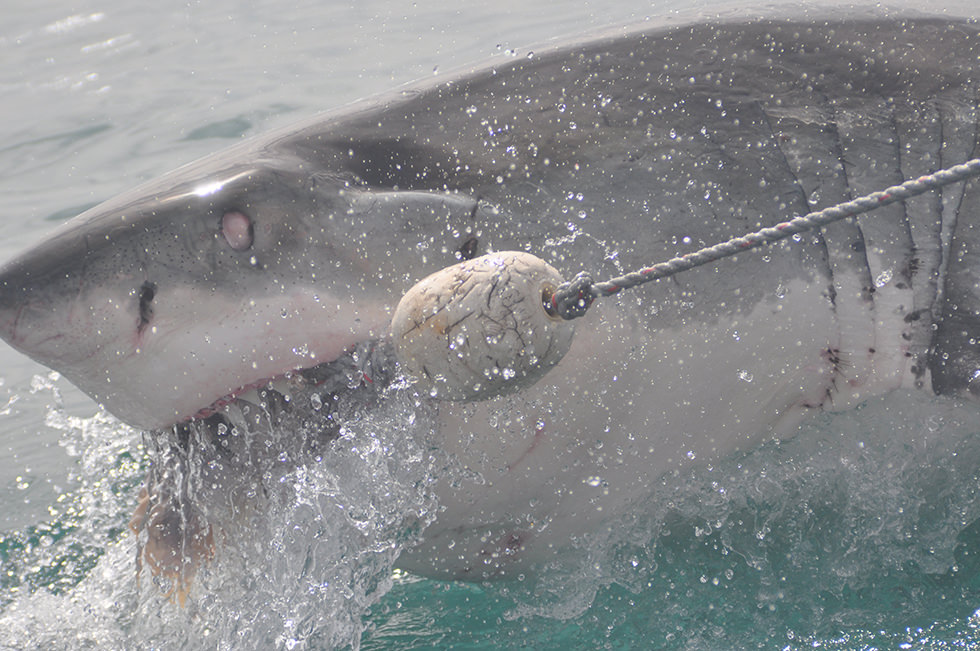
Sharks facts
Shark teeth are awesome
They can regenerate and change their teeth continuously during their lifetime, as we change between baby and adult teeth during our childhood. Sharks can lose more than 20,000 teeth, while we only lose 20 baby teeth. This strange strategy is very important to avoid broken teeth stuck on the jaw. It is not useful for the shark. A shark’s tooth shape is dependent upon its diet. There are four basic types of shark teeth that vary according to the diet of the shark: dense flattened teeth for crushing; needle-like teeth for gripping; pointed lower teeth for gripping and triangular upper teeth with serrated edges for cutting; and teeth that are tiny, greatly reduced and non-functional.
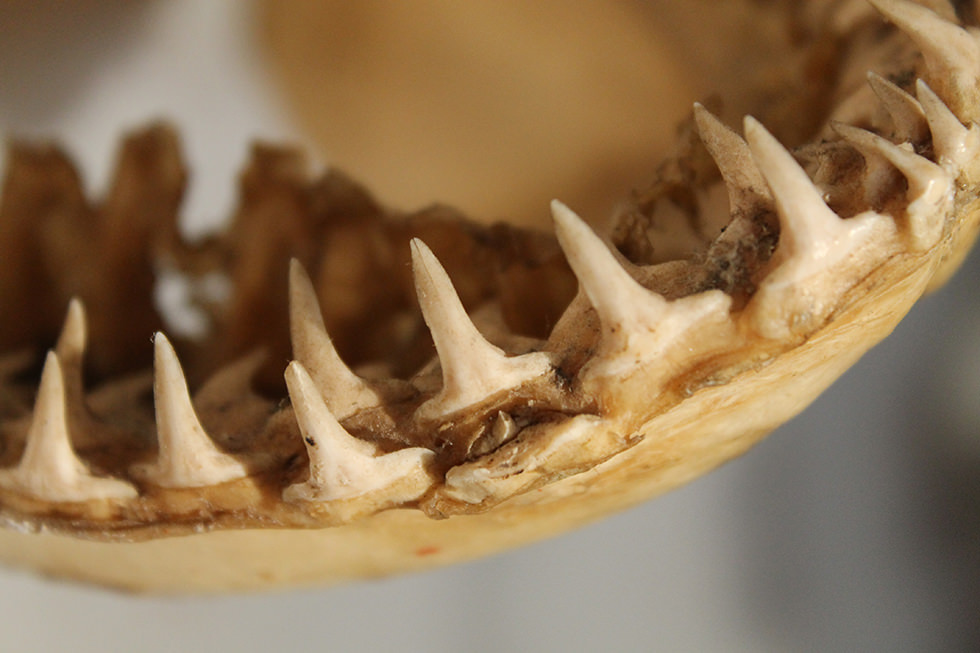
Shark sense: how to detect the hidden world
Sharks have a perfect set of sharpened knife-teeth to cut, crush and grip their prey, but what make them really formidable predators?
Imagine staying in a big room, completely dark, with your eyes closed, no smell, no noise, nothing, but you can feel the presence of someone. You can also understand the size and the movement of the other person and also predict the way the person is moving. This is one of the most important senses in the natural world: electroreception. In this way sharks can feel the presence of every organism around them and attack in the blue water of the ocean or under the sand with incredible precision and accuracy.
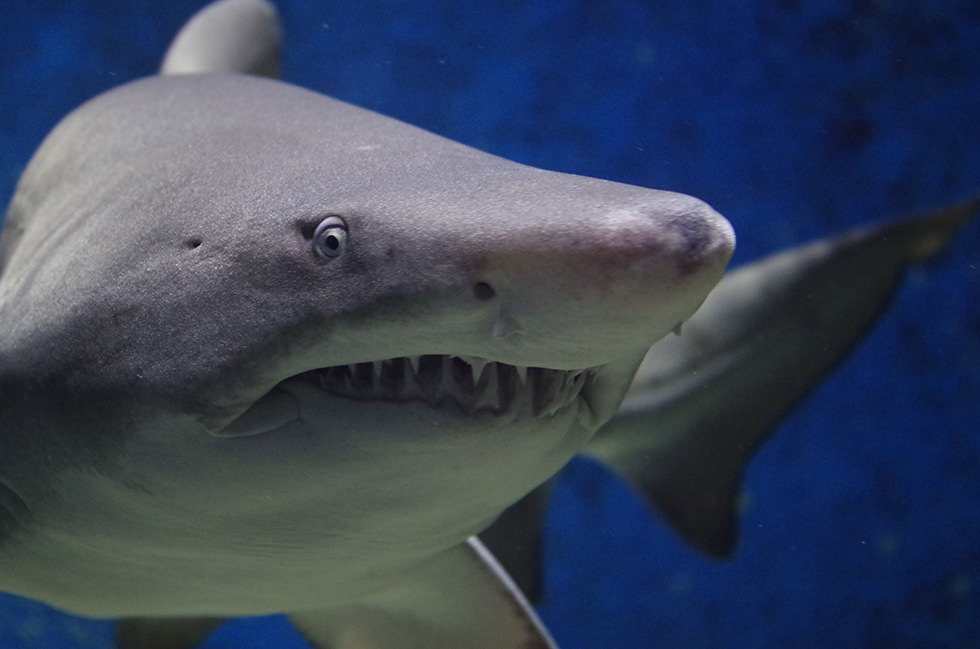
Tonic immobility: do you sleep supine?
Sharks don’t but they will fall into a trance if they are supine. A trance is when a being is disconnected from his or her normal conscious state. Scientists think that it happens when a chemical is released into the shark brain to prevent panic. The brain is probably flooded with the neurotransmitter called serotonin. When the brain is overloaded, the shark falls into a coma-like state. When the shark is in the right position the serotonin concentration decreases and the shark returns to consciousness. The second hypothesis is related to electroreception. The coma-like state is attained by touching the area surrounding the eyes where the Ampullae of Lorenzini are located. The Ampullae of Lorenzini are the receptors that activate electroreception. It is thought that it may alter the electroreceptive sense of the animal with tonic immobility. After touching the shark it will start again to swim. The process is always reversible.
Two penises: a funny way to ensure the continuity of the species
Actually, male sharks have no penises. They have grooved organs to deposit the sperm into the genital duct of a sexually receptive female shark. These organs, called “claspers,” are developed from each pelvic fin (the paired fins located behind a shark’s belly). Because the pelvic fins are paired, so are the claspers. It seems they only use one at a time. Sharks are not perverted.
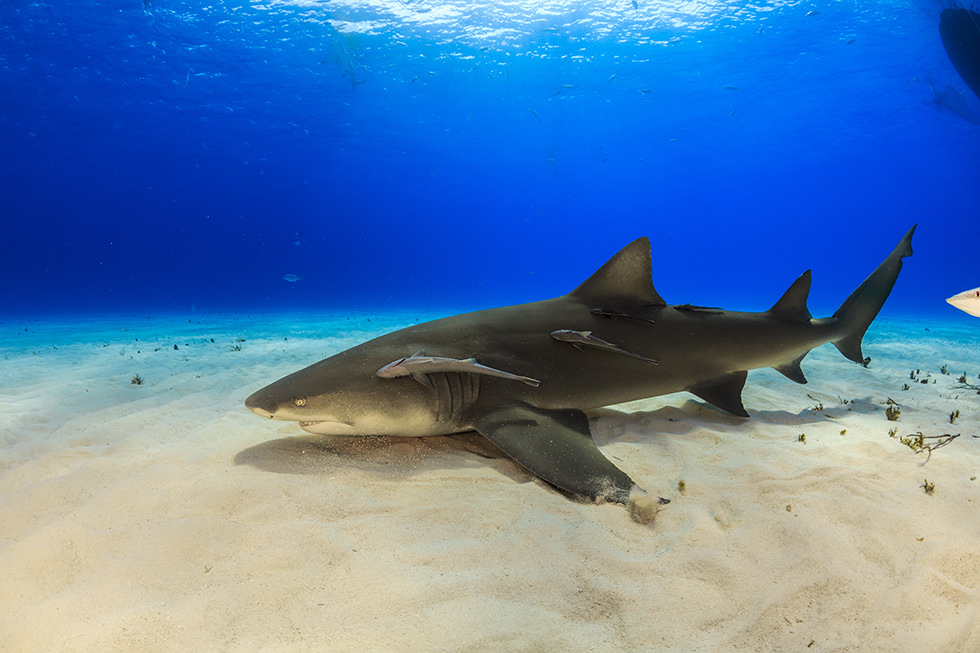
Credits
This article was written by Mario Passoni and Luca Saponari – two marine biologists involved in several projects concerning ocean conservation and education.
Special thanks to Jim Hancock from the Maldives Whale Shark Research Programme, John Richardson from Shark Trust, Victoria Elena Vasquez, and the photographers who allowed us to use their stunning images in this article.
